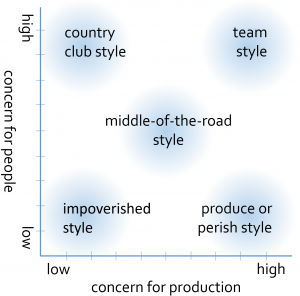I work in a company, where we have team leads, supporting the employees to develop and making sure that this development is aligned to the competitive goals of the company. I’m sure you can relate to this one way or the other. Maybe it’s a line manager or a department director or whatnot. That however is the leadership I want to discuss here. Not the leadership of a CEO towards the whole organization or the leadership of HR managers defining the development structures of an organization.
You can tell, it’s a little difficult to pinpoint. And while even scholars are still struggling to find a proper definition, they agree on 3 major characteristics:
- Leadership involves a direct social influence
- Leadership happens within an organization
- Leadership is always goal-oriented
Social influence always happens when people are interacting. Psychologists collect these under the term group dynamics. We’re social creatures, that’s what we do. Interact. In a gazillion different ways. It’s important here to understand, that leadership is not a one-way-street, but always has to be seen from the person being lead as well. Because in the end it is about the follower’s work.
I’ve got the power!
Leadership, as so many things in our world, is all about power. A leader often has 4 types of power over their followers: The power given to them through hierarchy, the power to impose sanctions, the power of more information and the power of charisma. While the first 3 are structural, based on the organization, the latter one is authoritarian. Many successful leaders are quite charismatic people and others like following them, because of this.
While leadership is about organizational goals, leaders are mostly judged according to the personal level and the relationship. Many employees who complain about their boss refer to their relationship to each other or the social behavior and not the professional abilities.
We generally over-estimate the impact of leadership. Especially for failures. The project managers are often blamed if the project was no success. People are romanticizing about this, expecting leaders to single handed change the world. Truth is that their influence is very limited and a lot of factors crucial for a project’s success are completely random or cannot be influenced by the leaders.
Yet, leadership comes naturally. Every group of people will always have a leader. Someone who seems more qualified for whatever reason, will become the leader of the pack. That’s how humans work, it’s easier to organize yourself this way.
The major thing when talking about leadership are the emotional needs of their followers. Besides all the structured aspects, resources and competences, each and every one of us hungers for recognition. Especially among our peers. We want to be recognized according to our abilities and as a part of the group and prove a valuable partner for interaction. That’s then why people identify themselves with the group, support each other, all this secures productivity.
Style is everything
Coming from Gestalt-Psychology, Kurt Lewin defined 3 leadership styles in the late 1930s: authoritarian, democratic and laissez-faire (Lewin, Lippitt, & White, 1939). Most modern leadership psychology is based on this. One of the latest fads in this area is Host-Leadership, which gained a lot of attention recently, comparing leadership to hosting a party (McKergow & Bailey, 2014). Both approaches are popular and simple. Leadership is not a simple thing though, and oversimplification might come at the cost of people. Hence, I would like to take a closer look at the managerial grid model (Blake & Mouton, 1964) here.
As discussed earlier, leadership is always about reaching the goals of a company. At the same time, leadership can help to take care of the people, feeding their individual needs. These can be considered as two dimensions, the concern for production and the concern for people. By creating a matrix out of these and giving names to the extremes plus one in the middle, Blake und Mouton defined 5 styles of leadership.
The indifferent or impoverished style shows low concern for production and people. In general this leadership style is focused on a minimum of influence on anything and basically characterized by not doing anything at all. Hence it is the least favorite of all leadership styles.
The accommodating or country club style shows high concern for people, but low concern for production. Managers focus on a comfortable atmosphere for the employees, not really exposing to the organization’s goals, though.
The dictatorial or “produce or perish” style shows high concern for production and low concern for people. It is fully focused on results, ignores the employees’ motivation and actually lowers it over time therefore. This control and dominate ideology is often utilized as a management strategy to deal with a crisis.
The status quo or “middle of the road” style shows mediocre concern for people and production. It is characterized by balance and compromise, keeps the working morale and the performance on appropriate levels, but far from peaking.
Finally, the sound or team style shows high concern for people and production. As you can’t have both at the same time, managers pick the right approach according to the situation, making the employees feel to be constructive parts of the company.
Situation & Context
When thinking about these 2 dimensions, it becomes very obvious, that they might be contradicting each other at times. You can’t always fully focus on the production and on the people at the same time. And if you try not ending up in extremes, you might end up in the middle, which again might not be what you really want. Striving for consistency results in mediocrity, you put a little bit of concern for the production and a little bit for the people.
The only way to achieve higher results in either is by not being consistently running the same leadership style, but by choosing the one that is appropriate to the specific situation. Individually. Host Leadership is a metaphor to help understanding these shifts. It all comes down to great leaders having a large repertoire of tools from which they pick the appropriate one for each situation. Great leadership is always situation-based.
To be specific, the situation looks into the context of the follower. Their maturity is a crucial aspect in the choice of the leadership method. Employee maturity here is defined through willingness, a combination of confidence, commitment and motivation, and ability, the experience, knowledge and skills for a specific task (Blanchard & Hersey, 1996). In the same matrix with concern for people (or employee-orientation) and concern for production (or task-orientation) we can find the leadership method that makes the most sense for the four combinations. As people would be transitioning through all the stages, it is called the “Life Cycle Theory of Leadership”.
| Name | Maturity | Method |
| Telling | Low ability Low willingness | Low employee-orientation High task-orientation |
| Selling | High ability Low willingness | High employee-orientation High task-orientation |
| Participating | Low ability High willingness | High employee-orientation Low task-orientation |
| Delegating | High ability High willingness | Low employee-orientation Low task-orientation |
Transformational leadership
Research showed that employees with higher motivation reach better results, hence different methods tried to increase the motivation, one of them being transformational leadership. It is a concept to shift the values and attitudes of employees from a self-centered perspective to a more holistic one, considering long-term goals. Four dimensions of transformational leadership support this, the 4I’s (Bass, 1985):
- Idealized Influence. The leader is a role model and earns credibility.
- Inspirational Motivation. By providing a vision the leader inspire their followers.
- Intellectual Stimulation. The followers are encouraged and empowered to think critically and creatively.
- Individualized Consideration. Every single person’s needs for support and development are being taken seriously and tackled systematically.
There is empirical evidence that transformational leadership results in a deeper bond between employees and the organization and that organizational citizenship behavior is more likely. And that followers are happier with their leader. And that the innovation, the creativity and the sales increase under transformational leadership.
Conclusion
Only when you pick the appropriate leadership method for the situation you will be able to focus on the big picture of motivated employees and efficient production. Leadership is never one size fits all, but highly customized according to the situation and context.
Bibliography
Bass, B. M. (1985). Leadership and performance beyond expectations. New York: The Free Press.
Blake, R. R., & Mouton, J. S. (1964). The Managerial Grid: The Key to Leadership Excellence. Houston: Gulf Publishing.
Blanchard, K. H., & Hersey, P. (1996). Great ideas revisited. Training & Development, 50(1), 42–48.
Lewin, K., Lippitt, R., & White, R. K. (1939). Patterns of Aggressive Behavior in Experimentally Created “Social Climates.” The Journal of Social Psychology, 10(2), 269–299. http://doi.org/http://dx.doi.org/10.1080/00224545.1939.9713366
McKergow, M., & Bailey, H. (2014). Host – Six new roles of engagement for teams, organizations, communities and movements. London: Solutions Books.




3 Comments
Don’t be so theoretical! – Open Minded · March 25, 2017 at 2:54 pm
[…] a society to understand the value of diversity, or helping a company to understand the need of transformational leadership, or helping a team to organize differently (#agile), or helping your clients (or however you want […]
Kulturwandel auf Schalke: Von Führung, Motivation und Christian Heidel. | Halbfeldflanke · June 18, 2017 at 9:04 am
[…] da autoritär handelt. Das wiederspricht sich nicht, sondern bestätigt die Führungsqualitäten. Führung ist immer abhängig vom jeweiligen Kontext und der speziellen […]
Company Culture: The Messy Kitchen Fallacy – Open Minded · December 4, 2017 at 9:38 pm
[…] key element is that a culture can’t be ordered by others (no, not by superiors either). Leadership creates followers, and followers do as their leaders do. If leadership believes the culture […]